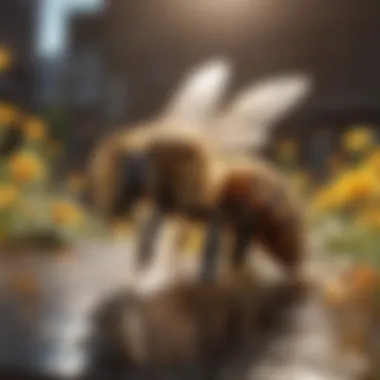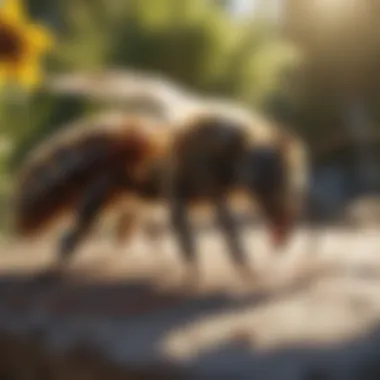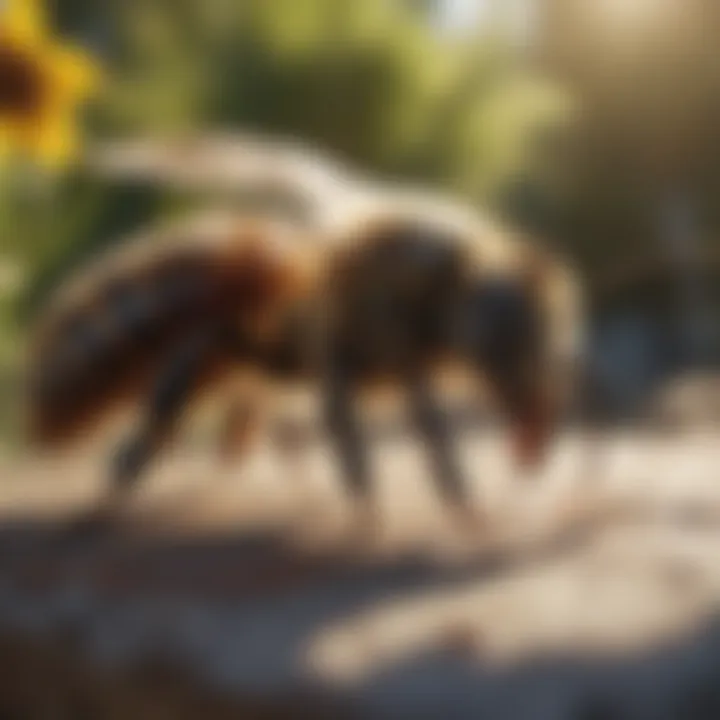Understanding Factors That Deter Bees from Your Home


Intro
Bee populations are vital for ecosystem health, but they can sometimes create challenges for homeowners. Deterring bees from residential spaces becomes necessary due to various factors that can either attract or repel them. Understanding these factors aids in creating a more harmonious setting for both humans and bees. By examining environmental, chemical, and structural elements, homeowners can manage bee presence effectively. This article covers the essential aspects of what makes bees stay away from certain areas, providing practical solutions and eco-friendly prevention techniques.
Understanding Pests
Definition of Pests
Pests are organisms considered harmful to humans, crops, and livestock. In the context of bees, they might not always be pests in the traditional sense, but they can create issues when nests or hives are established close to homes. Identifying whether bees are a nuisance or beneficial can help homeowners make informed decisions about bee management.
Importance of Pest Identification
Identifying bee species is crucial for various reasons. First, different bee species have divergent behaviors and nesting preferences. For example, honeybees often require larger nesting areas, while solitary bees may favor smaller spaces. Recognizing these differences helps homeowners to act accordingly. Furthermore, understanding the role of bees in pollination highlights the need to approach pest management carefully, considering both human comfort and ecological balance.
Prevention Techniques
Home and Garden Preventative Measures
To keep bees at bay, homeowners can adopt several strategies:
- Maintain Cleanliness: Ensure garbage bins are tightly sealed and food scraps are cleaned promptly.
- Seal Entry Points: Check for and seal any cracks or holes in the exterior of the home to prevent nesting.
- Plant Selection: Choose plants that are less attractive to bees, such as marigolds or geraniums, instead of those that produce high nectar levels like lavender or sunflowers.
Seasonal Prevention Tips
The behavior of bees changes with the seasons, necessitating various prevention techniques:
- Spring: Inspect and clean outdoor areas. Ensure flowers are managed and do not attract nests.
- Summer: Monitor bee activity carefully; avoid leaving food outside during gatherings.
- Fall: Prepare for the retreat of bees. Look for nests and consider removing them with professional help, if necessary.
- Winter: Seal off spaces to prevent winter nesting. Regular maintenance of the home can deter bees from returning in the warmer months.
Eco-Friendly Pest Control Solutions
Overview of Sustainable Practices
Adopting sustainable practices can help manage bee populations without harming the ecosystem. Some methods include:
- Using bee repellents derived from natural ingredients.
- Encouraging predator species that naturally control bee populations.
- Planting specific flowers that repel bees, but do not harm other insects.
Natural Remedies and Their Effectiveness
Homeowners can implement various natural remedies to deter bees:
- Vinegar Mixtures: A solution of vinegar and water can deter bees when sprayed around potential nesting areas.
- Essential Oils: Oils like peppermint and eucalyptus can repel bees. Mixing these with water creates a spray safe for the environment.
Understanding the factors that deter bees can lead to practical and eco-friendly solutions, creating a balance between human comfort and environmental preservation.
For those interested in learning more about bees and their ecological significance, resources from Britannica and Wikipedia offer comprehensive insights.
By implementing these measures and understanding the behavior of bees, homeowners can minimize unwanted interactions while promoting a thriving ecosystem.
Understanding Bees and Their Habits
Understanding the habits and behaviors of bees is essential for effectively deterring them from residential spaces. This knowledge not only aids homeowners but also emphasizes the importance of bees in maintaining ecological balance. Bees play a crucial role in pollination, contributing to the growth of various plants that sustain both humans and wildlife. Thus, recognizing how bees operate in their environment allows for a more thoughtful approach to managing their presence around homes.
The Role of Bees in the Ecosystem
Bees are integral components of our ecosystem. They facilitate the pollination process, which is vital for the reproduction of many flowering plants, including numerous crops. According to research, about one-third of food crops rely on bee pollination. Without them, many plant species would decline, leading to diminished food supply and biodiversity.
Understanding their role helps underscore why deterrent measures should focus on methods that respect their ecological function. Rather than extermination, approaches that minimize human-bee interactions while preserving bee populations are more beneficial.
Types of Bees Commonly Found Around Homes


Several types of bees may be encountered around homes, each with distinct characteristics and nesting preferences. The most common include:
- Honey Bees: Known for producing honey and residing in hives, these bees are social and usually found in colonies.
- Bumblebees: These are larger, fuzzy bees that often nest underground or in sheltered locations. They are social but less aggressive than honey bees.
- Solitary Bees: This group includes mason bees and leafcutter bees, which do not form colonies and typically nest in small cavities or tunnels.
Recognizing these various species can aid homeowners in understanding how to effectively deter their presence while remaining mindful of ecological health.
Bee Behavior and Habitat Preferences
Bees exhibit specific behaviors and preferences that dictate their nesting choices. Most bees seek out environments that offer good access to nectar and pollen. They prefer areas with fewer disturbances, making quiet, undisturbed gardens ideal for nesting. Moreover, the presence of various flowering plants can attract bees to a residence.
In terms of nesting, honey bees look for sites that provide protection, such as hollow trees or buildings. On the other hand, bumblebees may favor undisturbed ground spots for their nests. Solitary bees, as indicated, prefer small cavities, often found in wood or hollow plant stems.
This behavior informs how to create an uninviting environment through landscaping choices and habitat management. By understanding where and why bees choose to settle, homeowners can make informed adjustments to deter these important, yet sometimes troublesome, insects.
Factors That Deter Bees
Understanding the factors that deter bees can significantly benefit homeowners looking to minimize unwanted bee activity around their property. Awareness of these factors will not only aid in keeping bees at bay but also protect the local ecosystem. Specifying your approach can ensure that bees do not feel attracted to your home environment. By focusing on specific elements such as environmental conditions, chemical deterrents, and structural aspects, homeowners can create a less inviting landscape for these pollinators.
Environmental Conditions
Environmental conditions play a crucial role in determining whether bees will be attracted to a specific area. Various climate factors such as temperature, humidity, and seasonal changes affect bee behavior. For instance, warmer temperatures often lead to increased bee activity. Thus, maintaining an environment that does not support excessive warmth can be a simple yet effective strategy.
Moreover, areas with consistent moisture, such as puddles or leaking faucets, may attract bees seeking water sources for hydration. Therefore, ensuring proper drainage and fixing any leaks around the home can discourage bee visits.
"Understanding the local climate will help homeowners make informed decisions about bee deterrence strategies."
It is also advisable to consider the natural vegetation in your yard. Native flowering plants can lure bees, so opting for non-flowering plants can create a less appealing environment for them.
Chemical Deterrents
Chemical deterrents are widely used in attempts to repel bees. Some homeowners resort to commercial pesticides, but this may come with environmental risks. It is essential to use chemicals that do not harm beneficial insects, especially since bees are critical pollinators. When considering chemical options, look for products labeled as bee-safe.
Many natural solutions can also serve as effective deterrents. For example, essential oils like peppermint, citronella, and eucalyptus are known for their bee-repelling properties. These oils can be mixed with water and sprayed around entry points or outdoor seating areas. This natural approach minimizes harm to bees and the environment while also addressing concerns regarding unwanted bee presence.
Structural Elements of Homes
The structural elements of a home can influence bee behavior significantly. Small gaps and cracks provide access points for bees to nest. Regular inspections to seal any potential entry points are vital for prevention. Use caulk or weather stripping on doors and windows to ensure they are adequately sealed.
Additionally, the choice of materials can also have an impact. Certain materials, such as untreated wood, are more appealing for bees looking to nest. Homeowners may consider utilizing bee-repelling building materials or finishes that deter nesting. This simple change in material choice can help reduce bee attraction and nesting.
Landscaping choices should also be assessed in the context of home structure. Avoid planting bee-friendly flowers near entrances and patios, as this can draw them closer to the home. Incorporating plants that are less appealing to bees can provide an additional buffer against unwanted visitors.
Environmental Factors Affecting Bee Attraction
Understanding the environmental factors affecting bee attraction is critical for homeowners. These factors play a significant role in attracting or deterring bees from residential areas. Certain environmental conditions can create an ideal habitat for bees, while others can make such areas less appealing for them. The awareness of these elements can help homeowners implement strategies to reduce bee presence effectively.
Climate Considerations
The climate in which a home sits greatly influences bee behavior. Bees thrive in warm, sunny weather. High temperatures and the availability of flowering plants create a favorable environment for bees, increasing their activity. Conversely, colder climates or prolonged periods of rain can deter bees, as they seek sheltered, warmer areas.
One should also consider seasonal changes. For instance, bees are more active during spring and summer months when flowers bloom. If homeowners want to deter bees, they should be mindful of their planting schedules, opting for less attractive plants during these peak seasons. Some plants, like marigolds, have been known to repel bees, thus making them a good option for gardens during bloom times.
Natural Predators and Competition
Natural predators can also impact bee populations around homes. Birds, spiders, and other insects, such as wasps, can prey on bees or compete for resources. If a garden attracts these predators, it can lead to a decrease in bee visitors. Homeowners should strive for a balanced ecosystem in their gardens, which may inadvertently create an environment less inviting to bees. Additionally, areas with a high concentration of competing pollinators can deter bees from settling nearby as they compete for the same food sources.
Landscaping Choices and Their Impact
Landscaping choices have a direct effect on bee attraction. The type of flowers and plants selected dictates the presence of bees. Brightly colored, nectar-rich blooms naturally attract bees, while dense shrubs may provide shelter for them. Homeowners should consider incorporating barrier plants or herbs that tend to be less appealing to bees, such as mint or rosemary.
Your property can have specific features that also impact bee behavior. Standing water sources or open compost can attract bees, as they often need water for hydration and nest building. Maintaining a tidy yard, balancing flowering plants with non-flowering varieties, and removing standing water whenever possible leads to a less inviting environment.
Bees can thrive in areas with abundant flowers, but certain landscaping choices can deter them, making homes uninviting.
By understanding these environmental factors, homeowners can utilize strategic landscaping and maintenance efforts that create conditions less favorable to bees while still being conscious of maintaining an ecological balance.


Chemical Solutions to Repel Bees
Understanding chemical solutions for repelling bees is crucial for homeowners who seek to manage their interaction with these pollinators effectively. Bees, while beneficial to the ecosystem, can become a nuisance when they invade residential spaces. Chemical deterrents offer a pragmatic approach to keep them at bay. These solutions not only aim to repel bees but also consider their safety and the surrounding environment. Thus, it is important to carefully evaluate the efficacy and potential impacts of such chemical solutions.
In this section, we will discuss several categories of chemical solutions, focusing on essential oils, common pesticides, and homemade preparations. Each type presents its own advantages and consideration that homeowners should understand before implementation.
Essential Oils as Natural Deterrents
Essential oils have gained popularity for their natural repellent properties. Many homeowners prefer them due to their biodegradable nature and lower toxicity. Oils such as peppermint, citronella, and eucalyptus are particularly effective in deterring bees. These scents disrupt the bees’ ability to communicate and navigate, leading them away from targeted areas.
To utilize essential oils effectively, consider the following tips:
- Dilution: Always dilute essential oils with a carrier oil or water before application to avoid potential skin irritation.
- Application methods: Use a spray bottle for easy distribution around entry points and garden areas.
- Regular reapplication: Essential oils can dissipate quickly; therefore, regular applications are necessary, especially after rain.
Ultimately, essential oils serve as a safe and fragrant way to deter bees without harming the environment or the pollinators themselves.
Pesticides and Their Effects on Bees
While pesticides are oftentimes effective in controlling bee populations, their usage raises significant ethical and environmental concerns. Many pesticides are not selective, meaning they can harm beneficial insects along with pests. Chemical compounds found in common pesticides can have detrimental effects on bee health, leading to disorientation and death.
When considering pesticides, homeowners should:
- Research and understand the ingredients: Some products are designed specifically to target invasive species with minimal impact on native pollinators.
- Timing of application: Apply pesticides during early morning or late evening when bees are less active.
- Read labels: Always follow the manufacturer’s instructions for safe use and disposal.
Adopting less harmful alternatives is preferable to ensure bees can continue to play their essential role in pollination.
Homemade Solutions for Bee Prevention
For those looking for cost-effective and safe bee deterrents, homemade solutions can offer viable options. Simple household ingredients such as vinegar, soap, and water can be mixed to create an effective repellent. For example, a mixture of water and dish soap can block the bees’ ability to fly.
To work with homemade mixtures:
- Create a spray: Combine one cup of water with one tablespoon of dish soap in a spray bottle. This can be applied on areas where bees tend to gather.
- Test on small areas: Before applying broadly, conduct a small patch test to check for any adverse reactions on surfaces.
- Store safety: Keep mixtures in a secure location to prevent accidental exposure to children or pets.
"Homemade solutions provide an effective approach without the guilt of harming beneficial insect populations."
Home Design Considerations
Home design plays a crucial role in managing bee presence around residential areas. The choices made in building and landscaping can significantly affect how appealing a home is to bees. Effective design considerations not only protect personal spaces from these insects but also help in fostering a healthier ecosystem. By understanding the dynamics of bee behavior, homeowners can create an environment that is uninviting to bees while still being functional and attractive.
Sealing Entry Points
Sealing entry points is a practical and effective strategy to deter bees from invading the home. Common entry points include gaps around windows, doors, and vents. These openings can easily become an invitation for bees searching for shelter. Homeowners should inspect these areas regularly and seal any gaps using caulk or weather stripping. Not only does this help keep bees out, but it can also improve the energy efficiency of the home.
Another consideration is the installation of fine mesh screens on windows and vents. These screens allow for airflow while preventing bees from entering. Periodically checking for damaged screens and replacing them promptly is also essential. By addressing these vulnerabilities, homeowners can reduce the likelihood of bee encounters.
Building Materials That Repel Bees
The choice of building materials can greatly influence bee attraction. Certain materials are less attractive to bees and can help in creating an environment that discourages their nesting. For instance, using metal siding or composites instead of wood can be a more effective choice because they do not provide the same nesting opportunities. Wood is particularly inviting for bees, especially if it is untreated or has existing holes.
Moreover, it may be beneficial to treat wood surfaces with finishes that deter bees. There are also paints and coatings available that can provide a protective barrier against bee nesting. Integrating these materials into the design can significantly lower the risks associated with bee habitation.
Landscaping Features to Minimize Attraction
Landscaping decisions also play a vital role in keeping bees at bay. Homeowners should consider integrating features that are not conducive to bee attraction. For example, opting for low-nectar plants can minimize the likelihood of drawing bees to the yard. Avoiding flowering plants close to the home, such as lavender or bee balm, is advisable, especially during peak blooming seasons.
Additionally, maintaining a neat garden environment can deter bees. Overgrown areas and piles of debris can provide natural nesting sites. Regularly mowing the lawn and trimming back shrubs can help maintain an uninviting habitat for bees. Further, keeping the area around the home clear of standing water can prevent bees from gathering as they seek hydration.
"A small change in home design can lead to significant results in bee prevention."
By paying attention to home design, sealing entry points, selecting appropriate building materials, and making mindful landscaping choices, homeowners can successfully create an uninviting environment for bees. These considerations not only enhance comfort but also promote a balanced coexistence with the ecosystem.


Maintaining an Uninviting Environment
Maintaining an uninviting environment is crucial for keeping bees at bay. By focusing on specific elements of your home and property, homeowners can effectively discourage bees from establishing a presence. The benefits of adopting these practices are significant, not just for personal comfort but also for safety reasons.
Regular upkeep can disrupt potential nesting sites and food sources for bees. Beyond comfort, understanding the conditions bees prefer enables homeowners to adapt their surroundings accordingly. A few strategic changes in the home environment can lower the chance of a bee encounter.
Regular Maintenance and Cleanliness
Regular maintenance and cleanliness of your home can greatly contribute to making it less conducive to bee attraction. Bees are naturally drawn to places with abundant food sources. Hence, maintaining a clean environment drastically reduces the chances of bees visiting.
Keeping the yard tidy, trimming overgrown bushes, and ensuring that flowers are not overly abundant are practical steps. It is important to regularly clean any outdoor eating spaces to prevent food residues. Storing food properly and covering trash bins can prevent bees from being attracted to your area.
Proper Waste Management
Proper waste management plays a vital role in repelling bees. Accumulated waste, especially organic waste, can serve as a beacon for foraging bees. Homeowners should implement rigorous waste disposal methods.
- Ensure trash bins are sealed tightly.
- Use garbage bags that can withstand pest intrusion.
- Establish regular disposal schedules to avoid accumulation.
Using compost piles requires careful management, as they can attract bees if food scraps are improperly handled. Always ensure that compost is contained and monitored.
Eliminating Water Sources
Eliminating sources of standing water around your property is another effective approach to deter bees. Bees require water for various purposes, particularly for cooling their hives. Identifying potential water areas is key.
- Check for clogged gutters.
- Remove any standing water from flower pots or bird baths.
- Ensure that there are no leaks in garden hoses.
By maintaining a drier environment, you significantly reduce the likelihood of attracting bees, making your home less inviting for them.
Education and Awareness
Education and awareness are critical components in effectively managing bee populations around residential areas. This section underscores the necessity of understanding bee species, behaviors, and community involvement to create a harmonious living environment. A well-informed homeowner is less likely to engage in practices that unintentionally attract bees or provoke swarms. Education leads to informed decisions that can benefit both humans and bees, promoting coexistence rather than conflict.
Recognizing Bee Species
Bees are not a homogenous group. Understanding the distinctions between species can greatly impact how homeowners approach bee management. Common species such as the honeybee, bumblebee, and solitary bees exhibit varied behaviors and nesting preferences. For instance, honeybees are social and will form large colonies, whereas solitary bees prefer to build individual nests. Identifying these species can help in determining the appropriate response when bees are present. For example, if a swarm of honeybees is encountered, contacting a local beekeeper for safe relocation is advisable. Conversely, solitary bees may pose little threat and can be left undisturbed.
Understanding Bee Behavior to Minimize Encounters
Behavioral patterns also play a significant role in bee management. Knowing when bees are most active, and what attracts them, can assist homeowners in minimizing encounters. Bees are typically active during warmer months and are drawn to colorful flowers and sweet scents. Homeowners should consider adjusting their landscaping choices to incorporate less attractive plants. Keeping food covered and ensuring open garbage is appropriately managed can also reduce unwanted bee visits. Understanding that bees are typically non-aggressive unless threatened enables homeowners to act calmly when encountering bees, further decreasing the likelihood of a sting.
Community Awareness Programs
Community engagement is essential for widespread awareness and education. Local initiatives, such as workshops or informational sessions, can equip homeowners with tools and knowledge on how to deter bees effectively. Programs aimed at educating the public about the environmental benefits of bees can shift perspectives, fostering an appreciation for these creatures. This might include initiatives like community gardens using bee-friendly plants while implementing practices to manage their populations responsibly. Encouraging open dialogue and shared resources within neighborhoods can further enhance community cooperation in bee management efforts.
Community awareness fosters both understanding and appreciation of bees, ultimately leading to enhanced environmental stewardship.
Finale
In this article, we have explored the various factors that deter bees from making your home their habitat. Understanding these factors is essential for homeowners who want to minimize bee encounters while still respecting the vital role bees play in our ecosystem. By addressing environmental, chemical, and structural elements, we can create an uninviting environment for these insects without resorting to harmful practices.
Summary of Effective Bee Deterrence Strategies
When it comes to effectively keeping bees away, several strategies prove beneficial. Homeowners can consider the following:
- Seal Entry Points: Regularly check for and close gaps and cracks in the home’s foundation. Bees often seek out shelters in hidden spaces.
- Choose Landscaping Wisely: Opt for plants that are less attractive to bees, ensuring your garden remains a peaceful retreat.
- Maintain Cleanliness: Keep outdoor areas tidy. Accumulated food or waste can attract bees looking for easy resources.
Incorporating these practices into daily routines helps create a less inviting ecosystem for bees.
Final Thoughts on Coexisting with Bees
While the desire to deter bees from homes is understandable, it’s vital to appreciate their ecological importance. They are critical pollinators, contributing to the growth of various plants and food crops. Therefore, the focus should not solely be on elimination but on creating a balanced approach.
Even when deterrent measures are in place, homeowners should promote bee-friendly practices where possible. Consider supporting local bee populations by:
- Planting Bee-Friendly Flowers: Some plants support bees while not attracting them directly to home areas.
- Refraining from Unnecessary Chemicals: Chemical deterrents can harm bees and their colonies in the wider environment.
In understanding how to coexist successfully with bees, we enhance both our living spaces and the environment around us.



